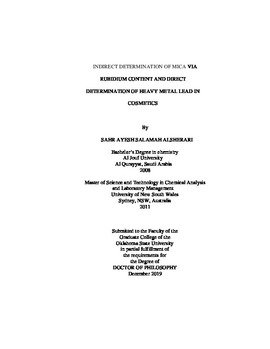| dc.contributor.advisor | Apblett, Allen | |
| dc.contributor.author | Alsherari, Sahr Ayesh Salamah | |
| dc.date.accessioned | 2020-04-09T20:53:40Z | |
| dc.date.available | 2020-04-09T20:53:40Z | |
| dc.date.issued | 2019-12 | |
| dc.identifier.uri | https://hdl.handle.net/11244/323825 | |
| dc.description.abstract | Millions of people worldwide use cosmetics daily and some of these are unwittingly exposing themselves to dangerous levels of toxic elements such as lead. In addition to lead, mica has been widely used in cosmetics for its shimmery and reflective effect. Ground mica powder is pearlescent and satiny, qualities that have made it a common ingredient in cosmetics where it provides a shimmery, glittery, and reflective effects. Though mica is harmless as a solid, its powder or dust can cause both short- and long-term health problems. A means of identifying cosmetics that contain mica would be useful to ensure that measures are taken to avoid inhalation of potentially harmful particles. An investigation was performed on more than one hundred cosmetic samples from countries all over the world checking them for lead and for rubidium ions that commonly contained in mica. The samples were acid digested and then analyzed using an Agilent Microwave Plasma-Atomic Emission Spectrometer (MP-AES). Moreover, these samples were investigated using an EDAX Orbis X-Ray Fluorescence spectrometer as a facile rapid non-destructive method to detect these elements in cosmetics without the necessity of dissolution. This part of the investigation consisted of making lead XRF standards using silica gel and rubidium XRF standards using muscovite mica. It was found that some of the cosmetics samples did contain high concentrations of these elements. Several of the samples exceeded The US Food and Drug Administration (FDA) maximum recommended level for lead in cosmetics (10 ppm). In order to avoid the necessity of acid digestion, the XRF spectrometer was calibrated using lead-containing silica gel standards and the same was done for rubidium using mica and rubidium-containing silica gel standards. This allowed the cosmetic samples to be quantitatively analyzed for lead and rubidium (mica) without destroying the samples. The XRF results were compared to the concentrations determined using MP-AES to validate the use of the XRF spectrometer for analysis of lead in cosmetics. A relationship between lead and mica has been identified that explains the mysterious existence of lead as in impurity in mica-containing cosmetics. | |
| dc.format | application/pdf | |
| dc.language | en_US | |
| dc.rights | Copyright is held by the author who has granted the Oklahoma State University Library the non-exclusive right to share this material in its institutional repository. Contact Digital Library Services at lib-dls@okstate.edu or 405-744-9161 for the permission policy on the use, reproduction or distribution of this material. | |
| dc.title | Indirect determination of mica via rubidium content and direct determination of heavy metal lead in cosmetics | |
| dc.contributor.committeeMember | Tahsini, Laleh | |
| dc.contributor.committeeMember | El Rassi, Ziad | |
| dc.contributor.committeeMember | Matts, Robert | |
| osu.filename | Alsherari_okstate_0664D_16599.pdf | |
| osu.accesstype | Open Access | |
| dc.type.genre | Dissertation | |
| dc.type.material | Text | |
| dc.subject.keywords | aes | |
| dc.subject.keywords | cosmetics | |
| dc.subject.keywords | lead | |
| dc.subject.keywords | mica | |
| dc.subject.keywords | risk | |
| dc.subject.keywords | xrf | |
| thesis.degree.discipline | Chemistry | |
| thesis.degree.grantor | Oklahoma State University | |
